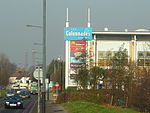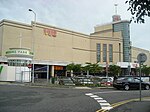Waddon Marsh tram stop
Railway stations in Great Britain opened in 2000Tramlink stops in the London Borough of CroydonUnited Kingdom tram stubsUse British English from May 2017

Waddon Marsh tram stop is a stop on the Tramlink service serving the area between Waddon and Croydon in the London Borough of Croydon. It is close to the commercial areas of the Purley Way. The stop is overshadowed by the giant gasometer of Croydon Gas Works. There was previously a railway station about 100 metres north of this site called Waddon Marsh, though all that remains of the previous station is an access path still lined with streetlamps painted BR red.
Excerpt from the Wikipedia article Waddon Marsh tram stop (License: CC BY-SA 3.0, Authors, Images).Waddon Marsh tram stop
Drury Crescent, London Broad Green (London Borough of Croydon)
Geographical coordinates (GPS) Address External links Nearby Places Show on map
Geographical coordinates (GPS)
| Latitude | Longitude |
|---|---|
| N 51.377 ° | E -0.1179 ° |
Address
Waddon Marsh
Drury Crescent
CR0 4XT London, Broad Green (London Borough of Croydon)
England, United Kingdom
Open on Google Maps










